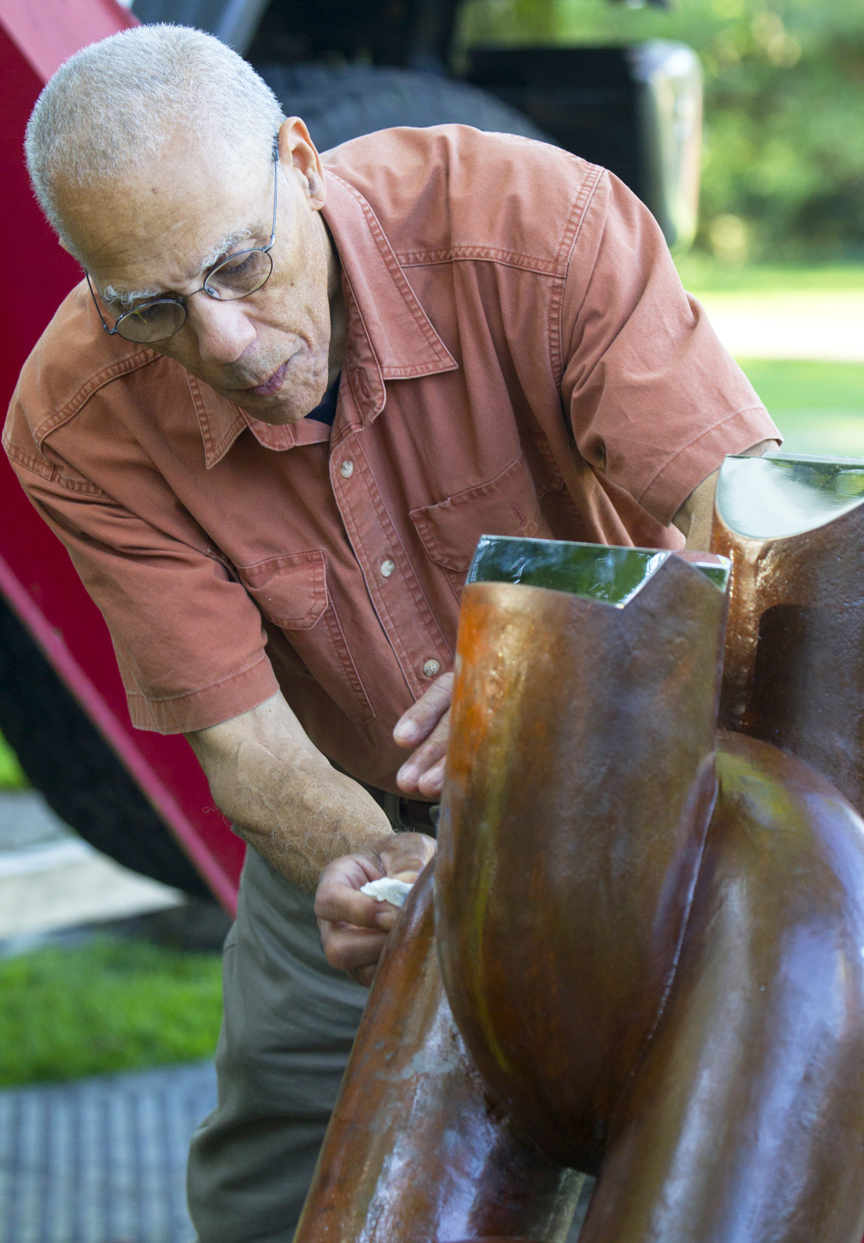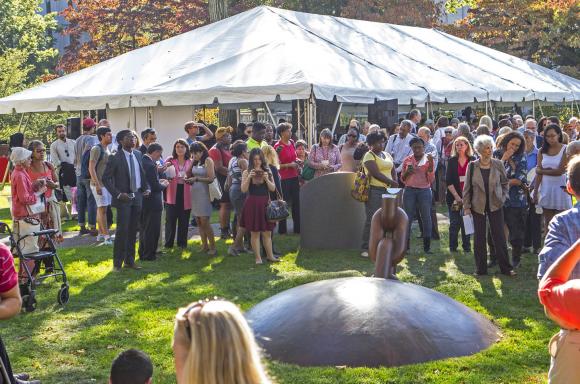PROVIDENCE, R.I. [Brown University] — On Saturday afternoon, Sept. 27, 2014, more than 300 University guests assembled on the Front Green for the dedication of the Slavery Memorial, a work by the American sculptor Martin Puryear.
Puryear’s memorial evokes a ball and broken chain, fashioned of cast iron, sinking into the Earth. The ends of the broken link are finished to a mirror-like surface, reflecting sky, sun, trees, life. A stone plinth installed near the walkway carries the legend, in part:
In the eighteenth century slavery permeated every aspect of social and economic life in Rhode Island. Rhode Islanders dominated the North American share of the African slave trade, launching over a thousand slaving voyages in the century before the abolition of the trade in 1808, and scores of illegal voyages thereafter. Brown University was a beneficiary of this trade.
A difficult and awkward assignment
Creating a memorial was one of the recommendations in the 2006 final report of the Steering Committee on Slavery and Justice. The committee recognized the “difficult and awkward” challenge of memorializing traumatic histories. A 10-member commission of University representatives and members of the public appointed by the governor of Rhode Island and the mayor of Providence was asked to consider how the slavery issue might be memorialized. The University’s Public Art Committee unanimously recommended Puryear for the project, and the Brown Corporation commissioned the work in February 2012.
Puryear, a MacArthur Award winner and 2011 recipient of the National Medal of Arts, is among the most honored American sculptors, with a retrospective organized by MOMA in 2007 and work shown in important international institutions since the late 1970s.
The Public Art Committee also recommended that the memorial be sited on the Front Green — the “Quiet Green” — between Hope College and Carrie Tower. The site was recommended for its prominence, especially during Convocation and Commencement, and for its historic significance as the site of the University’s earliest building.
“It is of course easier to forget injustice than to remember it,” President Paxson said at the start of the dedication ceremony. “Our minds are conditioned in the opposite direction – we would rather turn away from pain than face it. It is difficult enough to remember the past, without adding the burden of remembering the failures of the past. It requires an act of will. That is what we are here to ask of you.
“The reason this memorial is in such a prominent spot on our campus is that we know a polite remembrance is not enough,” President Paxson said. “We have an obligation, here at this citadel of free speech, to set a higher standard. We need to commit fully to the act of remembrance. We need to weave it into the daily rhythm of Brown University, and into all of the forms of work that we do on this campus. We must reject the forms of injustice that so freely circulated in 1764, and which have not disappeared nearly as neatly as we would like.”

“The most important takeaway from this whole enterprise is historic truth.”
Making the memorial
Bronze is the material of choice for heroic monuments, for works that celebrate cultural and historic achievements or famous people. Bronze was not an appropriate choice for a slavery memorial.
“I chose to create the work in iron — ductile cast iron, an industrial material,” Puryear said. “Ductile cast iron is not brittle like gray iron. It’s much more resilient and robust. It’s designed to last as long as any building on this campus.”
The dome — more than four tons of iron and more than two inches thick — was cast in an industrial foundry in Ohio. The chain with its mirror-polished broken link was cast at an arts foundry near Newburgh, New York. The granite plinth with its explanatory text — what Puryear considers the key element in the work, was realized nearby, in Seekonk, Mass.
Together, the sunken ball and chain and the stone plinth form a memorial that is both immediately accessible — “a blunt monument,” Puryear called it — and open to extensive observation, reflection, and interpretation. “For me, the most complicated part was finding the right tone,” Puryear said. “It had to avoid blame and moralizing. It simply had to present the facts. That was my strongest commitment — that it present the facts.”
Confronting the past
In his remarks, B. Anthony Bogues, professor Africana studies and director of the Center for the Study of Slavery and Justice, spoke of tragic, shameful events of history and of the wails of millions that troubled black abolitionist Frederick Douglass. He quoted President Emerita Ruth Simmons: “The past will not go away. You have to deal with it.”
“[The past] will not go away, I would suggest to you,” Bogues said, “because any past that is troubled haunts us. It haunts us until it is worked through.”
The memorial, Bogues said, beckons us to that task. “This memorial has chains which are open. Its last links are broken, but it is stretched upward. It calls upon us not to wade in the water, but to cross over the River Jordan to something else.”
The break in the chain is about a move to the infiniteness of freedom, Bogues said. To ignore the past and the struggles toward freedom, to avoid speaking of freedom and all that it entails — to do that is to once again close that open broken link.
See also
Text of remarks by President Paxson
Text of remarks by Martin Puryear
Text of remarks by B. Anthony Bogues

